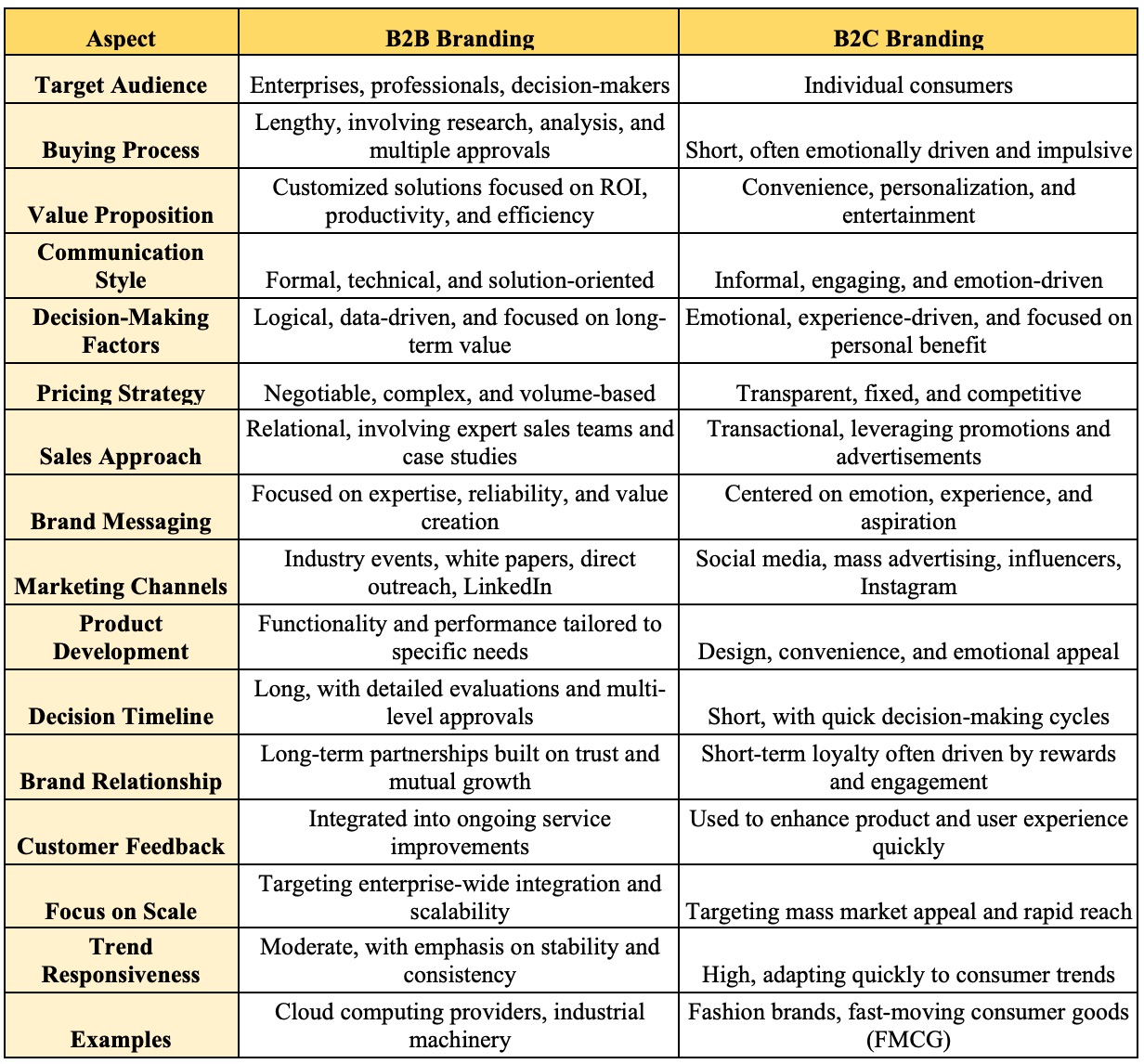Branding is the backbone of marketing, yet the strategies for Business-to-Business (B2B) and Business-to-Consumer (B2C) contexts vary substantially.
Differences arise from the nature of the target audience, decision-making process, and the communication style they require.
For aspiring marketing and business development professionals, understanding the distinctions between the two is critical for crafting effective, high-impact strategies that drive business results.
B2B branding focuses on meeting the operational needs of businesses by offering professional, customized solutions. It is rooted in building trust, industry alignment, and long-term relationships. At its core, B2B branding is about positioning a company as a reliable partner that enhances efficiency, reduces costs, and delivers measurable value. The buying process is lengthier and more complex, often involving multiple stakeholders as buyers evaluate solutions carefully, assessing their long-term return on investment.
In contrast, B2C branding appeals to the desires of individual consumers. It centers on personalization, emotional engagement, and responsiveness to market trends. In essence, B2C branding focuses on connecting with consumers’ emotions and lifestyles. Purchase decisions are typically faster and driven by convenience, brand loyalty, and the immediacy of benefits.
The Core Differences Between B2B and B2C Branding
To help quickly grasp the critical differences between B2B and B2C branding, the following table provides a side-by-side comparison of their key features. This resource is designed as a quick reference guide to help business professionals align their strategies effectively.
The contrast stems from the audience type. B2B brands aim to support enterprises in achieving operational efficiency and scalability, while B2C brands prioritise fulfilling personal needs and aspirations.
Strategic Goals and Execution
In B2B branding, the emphasis lies on establishing industry expertise and credibility. This requires deep research into the target industry, identifying trends, and addressing specific pain points. The execution involves showcasing customized solutions, leveraging case studies, and engaging expert sales teams to build trust. The ultimate aim is to foster lasting partnerships where both parties benefit.
B2C branding, on the other hand, seeks to build emotional connections. This is achieved through creative marketing campaigns that capture the consumer’s imagination and align with their lifestyle. B2C brands optimize their products and services based on consumer feedback, staying agile to meet shifting preferences. Building a community around the brand through loyalty programs and social media interactions is key to fostering brand loyalty.
The Branding Process
The process of B2B branding begins with a comprehensive understanding of the client’s industry. Identifying market trends, operational challenges, and competitor strategies sets the foundation for crafting tailored solutions. These solutions are often complex and designed to address specific problems that businesses face. Establishing credibility is critical, and B2B brands rely heavily on expert sales teams, case studies, and a strong portfolio to demonstrate their expertise. B2B branding is a long-term commitment. Successful execution involves periodic feedback and solution refinement to adapt to the evolving needs of clients. This iterative approach ensures that relationships deepen over time, creating a strong foundation for loyalty and trust.
In B2C branding, the focus shifts to understanding consumer preferences, habits, and aspirations. Audience segmentation is a crucial first step, where demographic and psychographic data are analyzed to craft personalized messages. B2C brands leverage emotional storytelling, often using vibrant advertising and social media to resonate with their target audience. Optimizing the customer experience is another vital element for B2C branding. From product usability to customer support, every interaction is refined to enhance consumer satisfaction. Community engagement plays a central role, with loyalty programs, interactive campaigns, and promotions fostering brand affinity. Unlike B2B, the B2C approach is more dynamic, requiring constant adaptation to trends and rapid market shifts.
Communication and Pricing Approaches
Communication strategies in B2B and B2C branding reflect their underlying goals. In B2B branding, the language is formal, technical, and solution-oriented. The aim is to present facts, figures, and tangible benefits. B2C communication, in contrast, is relatable and conversational. It focuses on creating an emotional connection, often highlighting how the brand aligns with the consumer’s lifestyle.
Pricing strategies also differ significantly. B2B pricing is complex and negotiable, tailored to the client’s unique needs and the scale of solutions provided. It often reflects the value delivered over time. In B2C branding, pricing is simple, transparent, and consistent. The goal is to make purchasing decisions easy and accessible for consumers.
Implications for Aspiring Professionals
For young professionals and consultants, mastering the nuances of B2B and B2C branding is essential. Working with B2B clients requires the ability to understand complex industry dynamics, build long-term strategies, and present measurable outcomes. Consultants must help B2B brands articulate their value proposition effectively, using data and case studies to build trust.
B2C branding, on the other hand, demands creativity and a deep understanding of consumer psychology. Consultants must focus on crafting engaging campaigns, optimizing user experiences, and leveraging digital channels to amplify the brand’s message. Agility and responsiveness are crucial, as consumer behaviors and trends can change rapidly.
The bottom line
B2B and B2C branding are distinct disciplines that require tailored approaches.
B2B strategies revolve around professionalism, trust, and long-term value, while B2C branding thrives on creativity, emotion, and adaptability.
For aspiring professionals, understanding these differences provides a foundation for delivering impactful, client-specific solutions.
Whether supporting enterprises or engaging consumers, the ability to navigate these complexities is a valuable skill that will distinguish future leaders in the consulting field.
Casey Ma is an MBA and MPH student at Yale University, specializing in Healthcare Management. With a background in strategy consulting, marketing, and project management, her passion lies at the intersection of healthcare transformation and strategic problem-solving. She is an advocate for collaborative innovation and enjoys engaging with professionals who share her enthusiasm for the healthcare and marketing sectors.
Image: DALL-E
🔴 Found these ideas useful?
Sharpen your edge

